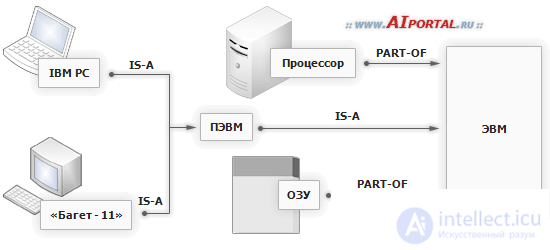The unambiguous definition of the semantic network is currently missing. In knowledge engineering, it means a graph that represents the meaning of a complete image. The nodes of the graph correspond to the concepts and objects, and the arcs correspond to the relations between the objects. Formally, the network can be defined as follows:
 - a lot of information units;
- a lot of information units; - many types of links between information units;
- many types of links between information units; - mapping specifying specific relationships from the available types
- mapping specifying specific relationships from the available types  between elements
between elements  .
.
The semantic network as a model is most often used to represent declarative knowledge. With the help of this model, such properties of the knowledge system as interpretability and coherence are realized, including relations

and

. Due to these properties, the semantic network allows to reduce the amount of stored data, provides for the conclusion of conclusions on associative links.
One of the first known models based on the semantic network is TLC-model (Teachaple Languge Compre-hender - an accessible mechanism for understanding the language), developed by Quillian in 1968. The model was used to represent semantic relationships between concepts (words) in order to describe the structure of a person's long-term memory in psychology.
As a rule, extensional and intensional semantic networks are distinguished. The extensional semantic network describes the specific relationships of a given situation. Intensional - the names of object classes, not individual object names. Connections in the intensional network reflect the relationships that are always inherent to objects of this class.
An example of a semantic network is a fragment of the description of computing technology shown in the figure.
Using such a network using the relation

and

, you can deduce the facts: “Baguette-11” is a computer; The IBM PC has a processor, etc. Procedural semantic networks are used to display procedural knowledge. In this case, the facts, relationships, and procedures are presented as vertices, and links unite them into a single concept.

 - a lot of information units;
- a lot of information units; - many types of links between information units;
- many types of links between information units; - mapping specifying specific relationships from the available types
- mapping specifying specific relationships from the available types  between elements
between elements  .
. and
and  . Due to these properties, the semantic network allows to reduce the amount of stored data, provides for the conclusion of conclusions on associative links.
. Due to these properties, the semantic network allows to reduce the amount of stored data, provides for the conclusion of conclusions on associative links.
 and
and  , you can deduce the facts: “Baguette-11” is a computer; The IBM PC has a processor, etc. Procedural semantic networks are used to display procedural knowledge. In this case, the facts, relationships, and procedures are presented as vertices, and links unite them into a single concept.
, you can deduce the facts: “Baguette-11” is a computer; The IBM PC has a processor, etc. Procedural semantic networks are used to display procedural knowledge. In this case, the facts, relationships, and procedures are presented as vertices, and links unite them into a single concept.
Comments
To leave a comment
Knowledge Representation Models
Terms: Knowledge Representation Models